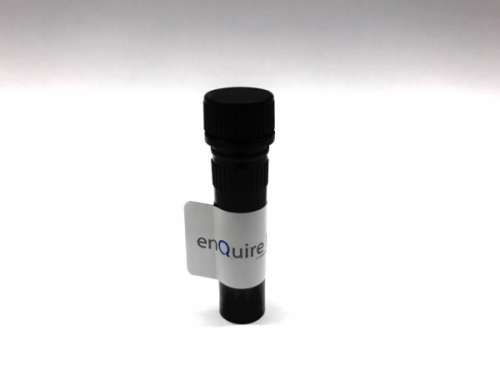Human Nuclear cap-binding protein subunit 2 Recombinant Protein Product Attributes
Product Type: Recombinant Protein
Recombinant Nuclear cap-binding protein subunit 2 based upon sequence from Human
Host: QP6407 protein expressed in E. coli.
Tag: GST
Protein Construction: A DNA sequence encoding the Homo sapiens (Human) Nuclear cap-binding protein subunit 2, was expressed in the hosts and tags indicated. Please select your host/tag option, above.
Recommended Applications: Immunogen, Protein Standard, Cell culture, or Other Cell Biology Applications.
Application Notes: Please contact us for application specific information for QP6407.
Bioactivity Data: Untested
Full Length? Full Length
Amino Acid Sequence: SGGLLKALRS DSYVELSQYR DQHFRGDNEE QEKLLKKSCT LYVGNLSFYT TEEQIYELFS KSGDIKKIIM GLDKMKKTAC GFCFVEYYSR ADAENAMRYI NGTRLDDRII RTDWDAGFKE GRQYGRGRSG GQVRDEYRQD YDAGRGGYGK LAQNQ
Purity: Greater than 80% as determined by SDS-PAGE.
Reconstitution Instructions: Concentrated protein in liquid format. Reconstitution is not necessary.
Concentration of Human Nuclear cap-binding protein subunit 2 Protein:
Endotoxin Levels: Not determined.
Buffer: Tris-based buffer, 50% glycerol
Storage Conditions: Store at -20C to -80C.
| Recombinant Human Nuclear cap-binding protein subunit 2 Protein General Information | |
|---|---|
| Alternate Names | |
| CBP20, NIP1, CBC2, PIG55 | |
| Curated Database and Bioinformatic Data | |
| Gene Symbol | NCBP2 |
| Entrez Gene ID | 22916 |
| Ensemble Gene ID | ENSG00000114503 |
| RefSeq Protein Accession(s) | NP_001036005.1 |
| RefSeq mRNA Accession(s) | NM_001042540.1, NM_001308036.1, NM_007362.3 |
| UniProt ID(s) | P52298 |
| UniGene ID(s) | Hs.591671 |
| HGNC ID(s) | HGNC:7659 |
| COSMIC ID Link(s) | NCBP2 |
| KEGG Gene ID(s) | hsa:22916 |
| PharmGKB ID(s) | PA31462 |
| General Description of Recombinant Human Nuclear cap-binding protein subunit 2 Protein. | |
| Component of the cap-binding complex (CBC), which binds co-transcriptionally to the 5′ cap of pre-mRNAs and is involved in various processes such as pre-mRNA splicing, translation regulation, nonsense-mediated mRNA decay, RNA-mediated gene silencing (RNAi) by microRNAs (miRNAs) and mRNA export. The CBC complex is involved in mRNA export from the nucleus via its interaction with ALYREF/THOC4/ALY, leading to the recruitment of the mRNA export machinery to the 5′ end of mRNA and to mRNA export in a 5′ to 3′ direction through the nuclear pore. The CBC complex is also involved in mediating U snRNA and intronless mRNAs export from the nucleus. The CBC complex is essential for a pioneer round of mRNA translation, before steady state translation when the CBC complex is replaced by cytoplasmic cap-binding protein eIF4E. The pioneer round of mRNA translation mediated by the CBC complex plays a central role in nonsense-mediated mRNA decay (NMD), NMD only taking place in mRNAs bound to the CBC complex, but not on eIF4E-bound mRNAs. The CBC complex enhances NMD in mRNAs containing at least one exon-junction complex (EJC) via its interaction with UPF1, promoting the interaction between UPF1 and UPF2. The CBC complex is also involved in ‘failsafe’ NMD, which is independent of the EJC complex, while it does not participate in Staufen-mediated mRNA decay (SMD). During cell proliferation, the CBC complex is also involved in microRNAs (miRNAs) biogenesis via its interaction with SRRT/ARS2, thereby being required for miRNA-mediated RNA interference. The CBC complex also acts as a negative regulator of PARN, thereby acting as an inhibitor of mRNA deadenylation. In the CBC complex, NCBP2/CBP20 recognizes and binds capped RNAs (m7GpppG-capped RNA) but requires NCBP1/CBP80 to stabilize the movement of its N-terminal loop and lock the CBC into a high affinity cap-binding state with the cap structure. The conventional cap-binding complex with NCBP2 binds both small nuclear RNA (snRNA) and messenger (mRNA) and is involved in their export from the nucleus | |
Limitations and Performance Guarantee
This is a life science research product (for Research Use Only). This product is guaranteed to work for a period of two years when stored at -70C or colder, and one year when aliquoted and stored at -20C.




There are no reviews yet.